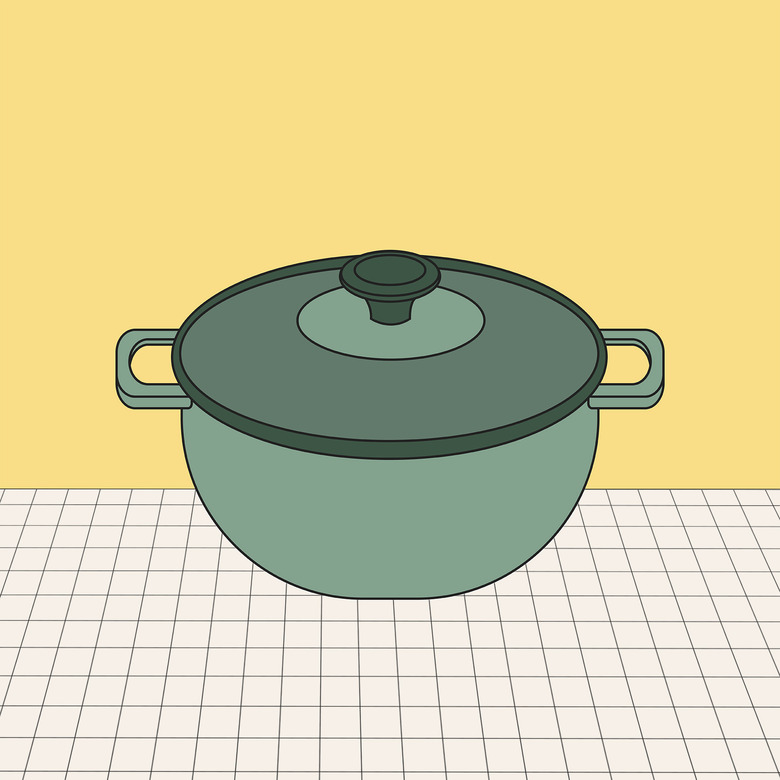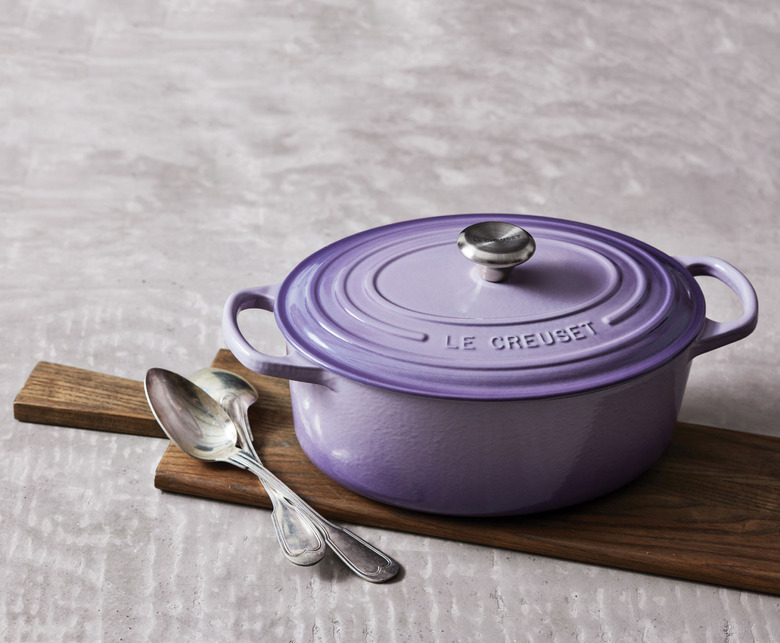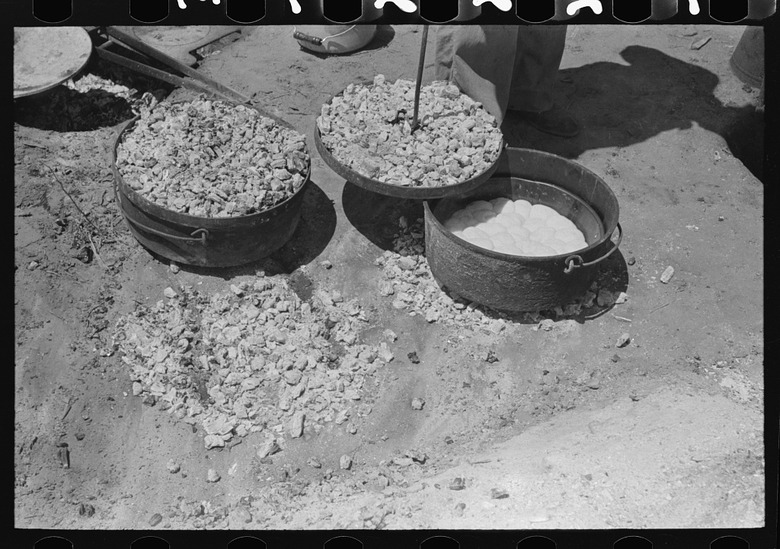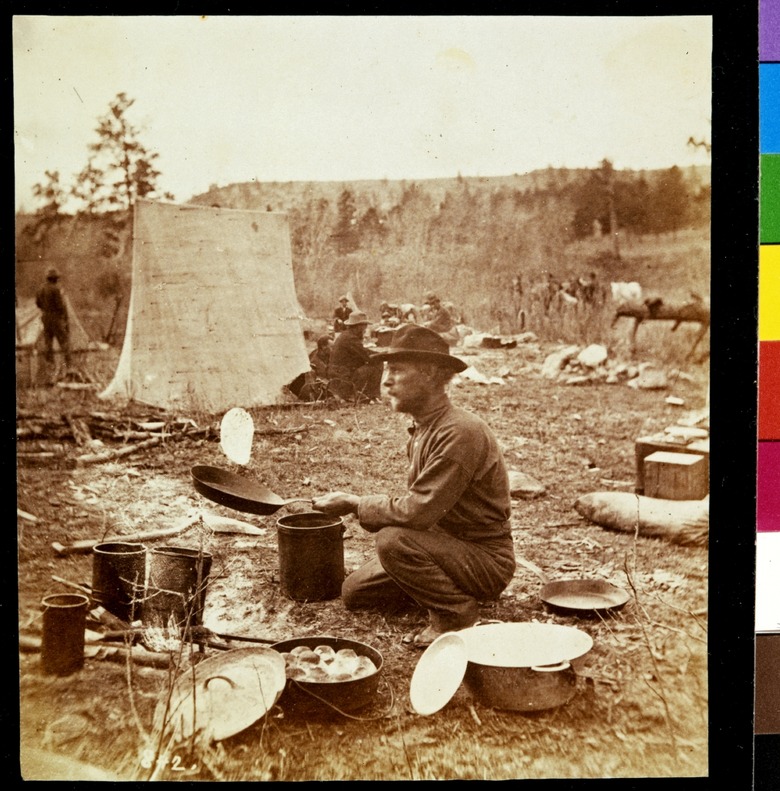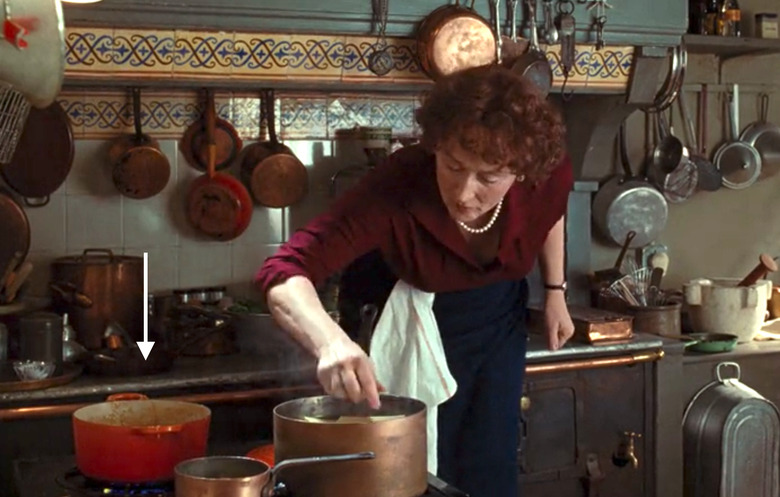So, Why Is It Called A Dutch Oven?
Hold on to your Le Creuset, because the story behind the Dutch oven is not nearly as fancy as the costly cookware.
In John G. Ragsdale's Dutch Ovens Chronicled, he quotes horticulturist and author Charles F. Saunders's description of the Dutch oven: "[a] homely pot on three legs, with a close-fitting lid." In the 1882 History of Trumbull and Mahoning Counties, they state, "The Dutch oven was an iron kettle which was provided with a cover capable of holding a heap of fire coals. The oven was placed upon the coals, and the heat thus applied to both top and bottom usually resulted in what housekeepers called a good bake." (Mary Berry would be proud.) Also called a bake kettle, bastable, bread oven, fire pan, and bake oven, some version of the Dutch oven has been used since the beginning of cookware in different parts of the world. Depending on where you go, it can have a different name — the French might call it a "cocotte" and the Japanese might say it's a "tetsunabe."
According to J. Wayne Fears in The Complete Book of Dutch Oven Cooking, the earliest mention he could find of a cast-iron cooking vessel like the Dutch oven was in a seventh century writing. The Merriam-Webster Dictionary, on the other hand, cites that in 1769, the term "Dutch oven" first appeared in print. They are referencing a copy of the Augusta County, Virginia court records from October 20th, 1769. Considering that this occurred during the eighteenth century, it's likely that the court records were referring to a modern version of the Dutch oven (more on that in a second).
Despite the concept of the Dutch oven being as old as cookware itself, the Dutch oven we know today was created in the early eighteenth century. In his book, Fears credits an Englishman named Abraham Darby with the first patent of the Dutch oven in 1708 (you can actually see an official writeup of the patent here). However, Darby didn't come up with the idea on his own. Having heard that Holland had superior metalwork techniques, he traveled there in 1704 to study how the Dutch cast brass vessels using dry sand molds (as opposed to the traditional clay ones). He soon perfected his own method using cast iron, a cheaper metal, and by the mid-eighteenth century, his pots were being shipped to the Colonies. Because of their Dutch origin, many think this is the reason the cooking vessels were called "Dutch pots" and later, "Dutch ovens."
Yet, there is another stance on why Dutch ovens were named so. According to Fears, many believe that the cookware's moniker comes from the traders who were selling the object all across America. Specifically, Dutch traders were allegedly the ones touting this popular ware, which is why it's believed people began referring to them as Dutch ovens.
Regardless of where its name comes from, the Dutch oven became a hot commodity as the American frontier was being explored during the nineteenth century. "The history of the Dutch oven in American history parallels the history of the country's western movement," writes Ragsdale, adding that this was the case because most people were cooking directly on the fire at the time. (The first gas oven wasn't invented until 1826 and they were initially found in wealthier homes.) That would be why the Dutch oven was especially popular among settlers and cowboys, who valued the cast iron pot for its versatility and durability. In fact, in 1805, Lewis and Clark expedition member Joseph Whitehouse wrote in his journal about having Dutch ovens on his trip, according to Fears's research.
As with most household objects, the Dutch oven's design changed over the years. Interestingly, Paul Revere — yes, the Patriot who rode through the night to warn colonists of a British attack during the American Revolution — is credited by some writers as having added a detachable handle, the three legs, and the flanged rim that allowed coal to sit comfortably on top of the pot. (However, none of this has been officially confirmed.) What we do know is that the Dutch oven, according to Fears, was used as cooking gear during the American Civil War and that in the early 1900s, it went on to become a staple at working camps for those in industries such as mining and logging, where one would likely find themselves in an area without an iron stove.
Ragsdale adds that during the twentieth century, the Dutch oven was primarily used by people who were camping or hunting away from the home. They could be used to bake, boil, stew, fry, and anything else you can think of, making it a great tool for when one is taking off into the woods. That would explain why Fears specifically credits the Boy and Girl Scout organizations with keeping the tradition of the Dutch oven alive through their camping programs. In a May 2016 copy of their "Recipes from Camping Skills Training" guide, the Girls Scouts of the Greater Los Angeles area mention eleven recipes specific to the Dutch oven. During the 1970s and 1980s, the oven's popularity also gained a boost when states such as Texas and Utah began holding Dutch oven cook-offs. In fact, in 1997, Utah's Online Library states that Utah made the Dutch oven their official State Cooking Pot.
Nowadays, you likely equate Dutch ovens with the popular Le Creuset brand — though Le Creuset's Dutch oven is actually considered to be a cocotte, the French version. In World Food, Mary Ellen Snodgrass states that the company sold its first enameled Dutch oven in 1925, in Fresnoy le Grand, France. It came in the cream, brown, and light blue hues (today, it comes in over a dozen colors). Thanks to chefs like Julia Child — who is known for making French cuisine popular in America — Le Creuset truly took off post-World War II, when home cooks became interested in making French dishes such as beef bourguignon. In 2015, in an article on Le Creuset's popularity, the company's senior brand manager at the time, Ingrid Lung, told The Independent that even the movie Julie & Julia — in which Meryl Streep, who plays Child, uses a Le Creuset — made the brand's sales soar.
If you could do without spending over $150 on a Le Creuset Dutch oven, fortunately, there are as many Dutch ovens out there, as the object's history is long. So whether you want to feel like Julia Child or Lewis and Clark, there is definitely a Dutch oven out there for you (and within your budget).
